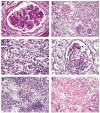The spectrum of kidney disease in patients with AIDS in the era of antiretroviral therapy
- PMID: 19052538
- PMCID: PMC2704860
- DOI: 10.1038/ki.2008.604
The spectrum of kidney disease in patients with AIDS in the era of antiretroviral therapy
Abstract
With prolonged survival and aging of the HIV-infected population in the era of antiretroviral therapy, biopsy series have found a broad spectrum of HIV-related and co-morbid kidney disease in these patients. Our study describes the variety of renal pathology found in a prospective cohort of antiretroviral-experienced patients (the Manhattan HIV Brain Bank) who had consented to postmortem organ donation. Nearly one-third of 89 kidney tissue donors had chronic kidney disease, and evidence of some renal pathology was found in 75. The most common diagnoses were arterionephrosclerosis, HIV-associated nephropathy and glomerulonephritis. Other diagnoses included pyelonephritis, interstitial nephritis, diabetic nephropathy, fungal infection and amyloidosis. Excluding 2 instances of acute tubular necrosis, slightly over one-third of the cases would have been predicted using current diagnostic criteria for chronic kidney disease. Based on semi-quantitative analysis of stored specimens, pre-mortem microalbuminuria testing could have identified an additional 12 cases. Future studies are needed to evaluate the cost-effectiveness of more sensitive methods for defining chronic kidney disease, in order to identify HIV-infected patients with early kidney disease who may benefit from antiretroviral therapy and other interventions known to delay disease progression and prevent complications.
Conflict of interest statement
All the authors declared no competing interest.
Figures



References
-
- Rao TK, Filippone EJ, Nicastri AD, et al. Associated focal and segmental glomerulosclerosis in the acquired immunodeficiency syndrome. N Engl J Med. 1984;310:669–673. - PubMed
-
-
System USRD USRDS 2007 Annual Data Report: Atlas of Chronic Kidney Disease and End-Stage Renal Disease in the United States. 2007.
-
-
- Mocroft A, Kirk O, Gatell J, et al. Chronic renal failure among HIV-1-infected patients. AIDS. 2007;21:1119–1127. - PubMed
-
- Szczech LA, Gupta SK, Habash R, et al. The clinical epidemiology and course of the spectrum of renal diseases associated with HIV infection. Kidney Int. 2004;66:1145–1152. - PubMed
-
- Wyatt CM, Winston JA, Malvestutto CD, et al. Chronic kidney disease in HIV infection: an urban epidemic. AIDS. 2007;21:2101–2103. - PubMed
Publication types
MeSH terms
Substances
Grants and funding
LinkOut - more resources
Full Text Sources
Other Literature Sources
Medical

